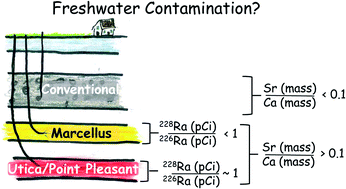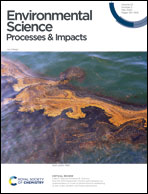Geochemical and isotope analysis of produced water from the Utica/Point Pleasant Shale, Appalachian Basin†
Abstract
While development of the Utica/Point Pleasant Shale (UPP) is extensive in Ohio (U.S.) and increasing in Pennsylvania and West Virginia, few studies report the chemistry of produced waters from UPP wells. These data have important implications for developing best management practices for handling and waste disposal, or identifying the fluid in the event of accidental spill events. Here, we evaluated the elemental and isotope chemistry of UPP produced waters from 26 wells throughout Ohio, Pennsylvania, and West Virginia to determine any unique fluid chemistries that could be used for forensic studies. Compared to the Marcellus, UPP produced waters contain higher activities of total radium (226Ra + 228Ra) and higher 228Ra/226Ra ratios. As with the Marcellus Shale, elemental ratios (Sr/Ca) and isotope ratios (87Sr/86Sr) can distinguish UPP produced waters from many conventional oil and gas formations. Sr/Ca and 87Sr/86Sr ratios can fingerprint small fractions (∼0.1%) of UPP produced water in freshwater. However, because Marcellus and UPP produced waters display similar major elemental chemistry (i.e., Na, Ca, and Cl) and overlapping ratios of Sr/Ca and 87Sr/86Sr, 228Ra/226Ra ratios may be the best tracer to distinguish these waters.

- This article is part of the themed collection: Contaminant remediation and fate


 Please wait while we load your content...
Please wait while we load your content...
